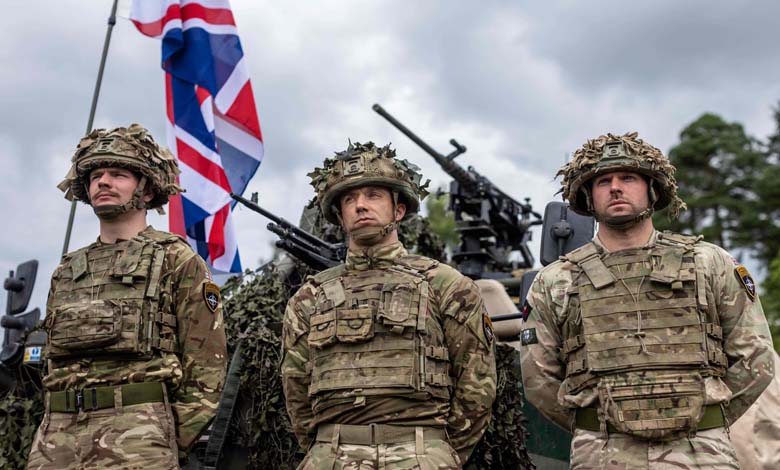The Future of the British Army: Costly Modernization or Looming Threats?

Amid military warnings that the state of the British Army has become “increasingly concerning,” senior armed forces leaders have presented the Prime Minister with “difficult choices.”
Between providing the British armed forces with a “national arsenal” of future weapons or risking war with Russia, these were the choices that Prime Minister Keir Starmer found on his desk during a meeting with British Army leaders, according to The Telegraph.
-
Operation “Kinova” reveals details of a British “conspiracy” in Ireland
-
To achieve equality… Proposal for mandatory conscription of women in the German Army
Senior military sources confirmed that the top commanders used face-to-face meetings with the Prime Minister on Friday to justify what their forces need to prepare for future warfare, arguing that investment would also support the government’s growth agenda.
Army leaders met with Keir Starmer as part of a series of in-depth briefings ahead of the Strategic Defense Review, amid ongoing debates over whether defense spending should be increased to 2.5% of GDP or even higher.
-
The Royal British Institute urges recognition of Sahara’s Moroccan Identity
-
The British Far Right Uses These Methods to Brainwash Children as Young as 9 Years Old
Former U.S. President Donald Trump had previously urged European nations to significantly raise their defense spending, even suggesting that NATO allies should allocate up to 5% of their GDP.
Senior U.S. officials reiterated this message at the Munich Security Conference over the weekend, fueling speculation that Keir Starmer might reconsider his stance. However, according to The Telegraph, Downing Street remains unwilling to go beyond 2.5% or revise existing plans to outline a timeline for reaching that target this spring.
-
The rejection of the two-state solution by the Israeli ambassador disappoints the British government
-
US army announces the killing of an ISIS leader responsible for terrorism in Europe
Defense Spending
A close ally of the Prime Minister told The Telegraph: “The policy we committed to during the election was 2.5% defense spending. Our policy remains 2.5%. We will not change that any further.”
However, The Telegraph learned that during Friday’s briefing, Keir Starmer was told that the army requires a massive modernization of its weaponry if it intends to deter Russia and China.
This overhaul would involve working more closely with the private sector to upgrade traditional weaponry, such as aircraft and tanks, with more lethal and unmanned systems.
-
British elections: Why Doesn’t King Charles and the Royal Family Vote?
-
Severe confrontations between Yemeni army and Iran-backed Houthis in Hodeidah
A senior military source familiar with the briefings stated that while traditional weapons remain necessary alongside future technologies, Downing Street must invest in tech companies specializing in first-person-view drones (where the remote pilot has a direct video feed from the drone), cheap munitions (also known as suicide drones), unmanned ground vehicles, and surface ships.
He added: “We need a national arsenal in the form of contracts for goods and services to achieve the ambitions of doubling combat power.”
-
UK’s Johnson Defends Kabul Airlift as Criticism Grows
-
British MPs Urge Cameron to Support Moroccan Autonomy Initiative
“In simple terms, while the majority of our lethal capabilities today come from highly advanced manned platforms, such as tanks or attack helicopters, in the future, we want to shift more of our lethal capabilities toward low-tech, unmanned systems.”
The source noted that expanding production lines in this new sector would place the UK ahead of its adversaries and help maintain national security.
-
Discover the 10 Most Powerful Armies in Europe: The United Kingdom in First Place
-
American-British Strikes Target Houthi Defense Systems Across Yemen
A military source stated: “Harnessing market power alongside strengthening our combat capabilities is the key to dealing with authoritarian states. Markets will do more than missiles in making these states think twice before engaging in war with us. We will be the first to invest if we invest now.”
More Lethal Forces
The source further explained that the shift in weaponry aims to make the army “more lethal” while also supporting the government’s growth strategy by creating a “more dynamic and engaged industrial sector.”
-
The Royal British Institute urges recognition of Sahara’s Moroccan Identity
-
The rejection of the two-state solution by the Israeli ambassador disappoints the British government
Last month, General Sir Roly Walker, Chief of the General Staff, delivered a speech warning that society perceives investment in defense as a moral mistake.
Last week, The Telegraph revealed that senior sources within the Ministry of Defense were concerned about the “public mindset,” as despite the war in Ukraine and Trump’s insistence that Europe bear more costs within NATO, British citizens did not perceive their nation as being at risk.
A military source remarked: “We have a problem because we don’t believe we have a problem. And that’s exactly what Russia and China want us to think. It’s simple (…) The time has come to make a decision, and citizens need to understand that. This is what we must do as a nation to ensure the security of the continent.”
-
British lawmakers are calling for the classification of the Revolutionary Guard as a terrorist organization
-
Israel Loses International Support: A British Newspaper Warns of the Continuation of the War in Gaza
However, multiple defense sources told The Telegraph that setting a fixed percentage of GDP for defense spending was akin to “putting the cart before the horse,” emphasizing that defining the exact needs of the Ministry of Defense should take priority before determining the budget.
Many senior army and navy officials expressed concern to The Telegraph over the government’s reluctance to commit to a clear timeline for increasing defense spending to 2.5% of GDP, with several arguing that the figure itself was insufficient from the outset.
Britain and Ukraine’s Security
According to The Telegraph, military leaders have advised the Ministry of Defense on how to increase spending to 2.5% by the end of Labour’s parliamentary term.
-
British Report Warns – Taliban-ruled Afghanistan becomes new terrorist safe haven
-
British Prime Minister: Iran destabilizes the region
A senior military source expressed hope that the government would heed the advice of military leaders, adding: “The situation is becoming increasingly concerning.”
Last week, it was announced that the United Kingdom would take over leadership of the Ukrainian Defense Contact Group from the United States.
This marks the first time Britain will lead the group, following instructions from the Americans to assume responsibility for strengthening Ukraine’s security within NATO.
-
British Prime Minister Liz Truss resigns after 45 days in office
-
British Envoy in Moscow to Try to Ease Ukraine Crisis
A senior British government source questioned how the UK could “afford” to support Ukraine while failing to replenish its own stockpiles of previous aid to the war-torn nation, all while struggling to secure adequate funding for its own defense.
The source told The Telegraph: “The ambitions of the armed forces will have to be curtailed unless the Ministry of Defense secures ‘a significant amount of sustained funding’ for defense over an extended period.”












